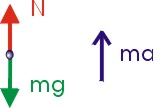Elasticity Laws of Motion One Dimension Motion
Question 1
A120 lb person is being lifted aloft by a rocket which accelerates uniformly to an upward speed of 300 ft/sec in 2 sec. What is the upward acceleration in multiples of g?
Question 2
A120 lb person is being lifted aloft by a rocket which accelerates uniformly to an upward speed of 300 ft/sec in 2 sec. What is the apparent weight of the person during acceleration?

Free body diagram: N - Normal reaction which is equal to the apparent weight of the man.
Question 3
A short 10 gram string is used to pull a 50 gram toy across a frictionless horizontal surface. If a 3.0 x 10 Newton force is applied horizontally to the free end. Find the force of the string on the toy, at the other end.
Question 4
A rocket exhausts fuel with a velocity of 1500 m/s, relative to the rocket. It starts from rest in outer space with fuel comprising 80% of the total mass. Find its speed when all the fuel has been exhausted.
Hint 4
Find the final mass of the rocket when the gasses have exhausted. Then use the ratio of the initial mass of the rocket and the mass at instant of time to find the velocity
Answer 4
Exhaust speed of the gases = 1500 m/s = u
Initial mass of rocket + fuel = M
Mass of fuel = 80% of M
Final mass of rocket when the gases have been exhausted = 20%M = 0.2M
Velocity of the rocket at any time = v
v = u x 2.3o3logmo/m
Where mo/m is the ratio of the initial mass of the rocket to its mass at the instant of time
v = 1500 x 2.303 log M / 0,2M
= 2414.6 m/s
Question 5
A 640 N acrobat falls 5.0 m from rest into a net. The net tosses him back up with the same speed he had just before he hit the net. Find the average force exerted on him by the net during this collision.
Hint 5
When the acrobat bounces back the impulse acting on the acrobat = Change in momentum = m [v-(-v)] = 2mv
Answer 5